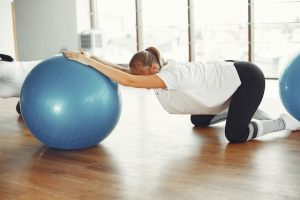A Physiotherapist’s take on active birth skills.
With ample birth skills resources out there, new mothers wouldn’t be alone in being confused on where to even start. An oldie but a goodie is “Birth Skills” by Physiotherapist Juju Sundin.
I will preface this by saying that learning birth skills does not guarantee a pain-free birth, or a drug-free birth. Nor, does it guarantee a specific type of birth. Active birth skills are a means of education for expectant mothers (and their partners/support team), It enables empowerment during their unique birthing experience should they want, need or require them. They are not a rule book nor are they pivotal, instead they are skills for you to call upon if desired to allow you to feel in control of your pain/experience/stress during labour.
Above all, it is important to be guided by your medical team (midwives and obstetricians) as even the best laid plans can need to be changed last minute.
Below is a simple summary of some (not all) of the birth skills, techniques and information from Juju Sundin’s fabulous book.
Birth skills are best broken down based upon the stages of labour:
- First stage: contractions dilate (open) the cervix, rotation and movement of the baby down into the pelvic region.
- Second stage: the pushing phase whereby the baby moves through the birth canal and into the outside world.
- Third stage: expelling of the uterus and placenta.
One thing common to each of these stages is that birth pain is healthy pain. Labour pain in its simplest form is the uterine muscle working under fatigue. It’s just like the healthy glute pain that you get from doing a set of butt busters in your pilates class at PMPP.

Skills for the First Stage of Labour
During the first stage of labour pain is most commonly felt in your middle and lower abdomen, lower back and/or thighs. The aim of the first stage skills are to:
- Use your pain free body parts to take your pain away from the contracting uterine muscle. The brain can only focus on one area of pain at a time. Therefore, you can use your pain free areas to create sensations which override your brain’s awareness of the uterine pain.
- The brain will choose to focus on the most dominant sensation, you’ll want to match the intensity of the exercise/skill to the intensity of your pain (i.e. start off with a gentle/slower/calmer version of each skill, then once contractions get stronger use harder/faster/more intense version of the technique).
Skill: Movement
Purpose: Use and focus on your pain-free legs (not the uterine pain) to bombard the brain with other sensory messages. Movement helps to release endorphins and reduce adrenaline (stress). Focus on the senses associated with the movement (sounds of the movement, your breathing, what you’re feeling under your feet etc.).
Example Technique:
- March on the spot.
- Intensify this by: stomping on the spot, marching on water in the shower focusing on the splash, add arm movements to each step (clap, squeeze a ball).
Skill: Vocalisation
Purpose: Use sound and breathing to re-shift your attention away from the labour pain by focusing on rhythm. Vocalisation helps to block panic/stress and prevents holding of the breath which makes pain worse.
Example Technique:
- Breath blowing: blow through pursed lips.
- Intensify this by: breathing louder, focus on the sound and feel, add imagery (i.e. close your eyes and imagine blowing a paper boat across a pond).
Skill: Visualisation
Purpose: Focus on images, memories, scenes (the possibilities are endless) to shift your focus away from the pain and remain calm.
Example Technique:
- Story-telling: Have your partner tell you a story in a familiar setting such as a visualisation of walking down your street.
- Intensify this by: imaging smells in the suburb, walking as your partner explains the story.
Skill: Touch and Feel.. Stress Balls!!
Purpose: Use the millions of nerve endings in the pain-free hands to supersede the brain’s awareness of the uterine muscle pain.

Example Technique:
- Squeeze the balls rhythmically then relax.
- Intensity this by: tapping the balls together, tapping the balls while you stomp your foot, focus on the colour of the balls while you bang them together.
Skills for the Second Stage of Labour.
The second stage is the pushing stage once the cervix is fully dilated to 10cm. The skills that you use here are opposite to the ones used in the first stage. In the first stage you externalise sound and breath to take your awareness away from the pain. In the second stage of labour you internalise your vocals and breath to help generate pressure from the diaphragm, abdominals and uterus to push the baby out. The best way to prepare for the pushing phase is to use visualisations. I recommend reading JuJu’s book for some great examples of pushing visualisations.
Crowning is also considered in the second stage of birth. This is the moment right before you meet your baby, it’s when your baby first starts to show the tip of their head. Panting (short, shallow breaths) can help during the crowning process.
Some Other Tips for Labour:
- Practise the skills. Have a list of the ones you think you’ll want to use so that your birthing team/partner can remind you of them and encourage them.
- Acknowledge that different techniques work for different people. The tricky part is that you don’t know which ones you’ll like the most until you are in the moment – so practice them all!
- Conserve your energy during labour as best you can – adopt the strategies that use the least amount of energy first (i.e breathing) so that you don’t tire yourself out too early (save the stomping until you really need it). Relax between contractions and surges.
- TENS machines are another great tool for pain management. Your physio at PMPP can teach you how to use these and we have them available to hire.
- Perineal massage is another handy tool to keep up your sleeve as early birth preparation since it has great benefits for this phase. Our pelvic floor physiotherapists are experienced in teaching you this skill and its benefits.
How can PMPP help?
As always your friendly physiotherapists at PMPP are always happy to help you in your prenatal journey.
We recommend a postnatal physiotherapy check at the 6 week mark. Contact our team if you would like to find out more about these checks. They are suitable for ALL women, irrespective of your birthing experience or type of delivery. And, we love baby cuddles so feel free to bring them in with you!
~ Emily Tregear
Physiotherapist
Find our PMPP Bump & Beyond Ebook here. Filled with great tips, exercise adaptations and guidelines for your pregnancy and postpartum journey. https://portmelbournephysio.com.au/product/ebook-bump-beyond-pregnancy-and-post-natal-guide/
You may find these other PMPP blogs interesting:
- https://portmelbournephysio.com.au/the-fourth-trimester-2/
- https://portmelbournephysio.com.au/why-a-post-natal-physio-check-up-is-essential/
- https://portmelbournephysio.com.au/exercising-post-baby/
- https://portmelbournephysio.com.au/for-the-new-mums/
- https://portmelbournephysio.com.au/mastitis-update/

Ali and baby Claudia, 5 minutes old 🙂

